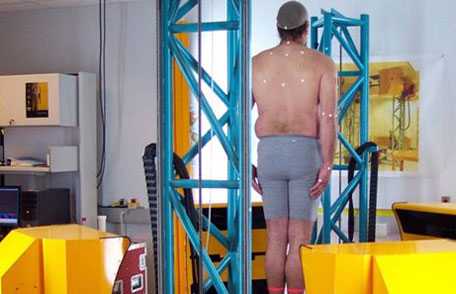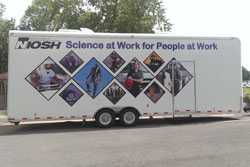Keeping Workers Safe
 Studying workers’ sizes and shapes and how they perform tasks can prevent injury on the job. CDC offers manufacturers, employers, and others important resources and research findings for improving the workspaces, machines, vehicles, and personal protective equipment of workers.
Studying workers’ sizes and shapes and how they perform tasks can prevent injury on the job. CDC offers manufacturers, employers, and others important resources and research findings for improving the workspaces, machines, vehicles, and personal protective equipment of workers.
What is engineering anthropometry?
Engineering anthropometry (an″thro-pom´ĕ-tre) is the science of defining a person’s physical measures, such as their size and shape. CDC’s National Institute for Occupational Safety and Health (NIOSH) conducts engineering anthropometric research to prevent work-related injuries and deaths by studying how work spaces and equipment fit today’s diverse worker population. This includes the fit of tools, machines, vehicles, and personal protective equipment (PPE).
Before NIOSH began anthropometry research in the early 2000s, anthropometric data from the surveys of military personnel collected in the 1950s and 1970s were used. These decades-old data do not represent the sizes and body types of today’s workers who are much more diverse in age, gender, and ethnicity.
Why does engineering anthropometry matter?
Research has shown that there are unique shapes and sizes for specific occupations.1 For example, research has shown that truck drivers are heavier than the average U.S. population,2 and that firefighters have larger upper bodies than the rest of the population.3 These findings support the need for redesigned tools, machines, vehicles, and PPE to keep our workforce safe and healthy.
The differences in the body sizes and shapes of today’s workers compared to past data, as well as limited availability of proper fitting PPE, can contribute to worker injuries and deaths. However, engineering anthropometric research has great potential to support worker safety and health for:
- Re-designing equipment and workspaces to better meet the needs of workers
- Developing PPE that fits and works better
- Making PPE more comfortable
Using anthropometric data to design tools, machines, vehicles, and PPE that better fit today’s workers is an important part of CDC’s Prevention through Design (PtD) program, which promotes ways to minimize hazards and risks at worksites. A few examples of PtD are CDC’s research on head-and-face anthropometry and 3-dimensional (3D) head models of industrial workers, which were incorporated into technical specifications of the International Organization for Standardization’s (ISO) standards for testing new respirator facepieces and have been used by many manufacturers to improve respirator and eye protection designs.
What engineering anthropometric research is CDC doing?
Research
Most recently, researchers at CDC developed and published the first-ever federal summary of truck driver anthropometry data and have a number of firefighter anthropometry publications for use in equipment and work space design. The data from this research was provided to truck manufacturers and fire service partners. Truck manufacturers are currently using the data to redesign truck cabs, while fire service partners are redesigning seat belts, seats, gloves, self- contained breathing apparatus (SCBA) carrying straps, and protective clothes.
In addition to truck drivers and firefighters, CDC has studied construction workers, farmers, and meat processing workers. Researchers have examined equipment as well, such as farm tractor-cab layout and fall-arrest harness systems. CDC also recently finished data collection on emergency medical service workers and is gearing up to collect data on law enforcement officers.
Some of CDC’s studies and research on engineering anthropometry include:
Engineering Anthropometry
- Anthropometric differences among occupational groups
- Anthropometric procedures for protective equipment sizing and design
Firefighters
- Firefighter hand anthropometry and structural glove sizing: a new perspective
- Seat and seatbelt accommodation in fire apparatus: anthropometric aspects
- Sizing firefighters: method and implications
Harnesses
Respirators
- Digital 3-D headforms with facial features representative of the current US workforce
- Head-and-face anthropometric survey of U.S. respirator users
- A new approach to developing 3-D headforms
Truck Drivers
- Anthropometric study of U.S. truck drivers: methods, summary statistics, and multivariate accommodation models
- U.S. truck driver anthropometric study and multivariate anthropometric models for cab designs
Research Labs
Most of CDC’s research on workers’ physical measures takes place in the Anthropometry Labs. The Morgantown, WV and Pittsburgh, PA labs were developed in 1995 and 2001 respectively, and they are two of only several in the world with advanced technologies for collecting highly accurate anthropometric data.
Computer-generated human models are available for analysis through 3D digital scanning. The lab is equipped with a:
- Full-body scanner,
- Head scanner,
- Foot scanner, and
- Hand-held scanning device for stationary or concave objects.
These scanning devices produce high resolution scans within seconds.

Mobile anthropometry lab that travels around the country collecting worker body dimension information.
Mobile Lab
In addition to the onsite Anthropometry Lab, CDC has a Mobile Anthropometry Lab that includes a body, foot, hand, and head scanner all inside a 30-foot long trailer. This lab on wheels allows researchers to study hard to reach workers across the nation. The Mobile Anthropometry Lab has traveled across the U.S. making stops in Boise, ID; Ft. Worth, TX; New Haven, CT; Phoenix, AZ; Minneapolis, MN; Richmond, VA; and Tallahassee, FL.
References
- Hsiao H, Long D, Snyder K [2002]. Anthropometric differences among occupational groups. Ergonomics 25(2):136-152.
- Guan J, Hsiao H, Bradtmiller B, Kau T-Y, Reed MR, Jahns SK, Loczi J, Hardee HL, Piamonte DPT [2012]. U.S. truck driver anthropometric study and multivariate anthropometric models for cab designs. Hum Factors 54(5):849–871.
- Hsiao H, Whitestone J, Kau T-Y, Whisler R, Routley JG, Wilbur M [2014]. Sizing Firefighters: Method and implications. Hum Factors 56(5):873–910.
- Page last reviewed: October 15, 2015
- Page last updated: October 15, 2015
- Content source:
- National Institute for Occupational Safety and Health
- Page maintained by: Office of the Associate Director for Communication, Digital Media Branch, Division of Public Affairs




 ShareCompartir
ShareCompartir